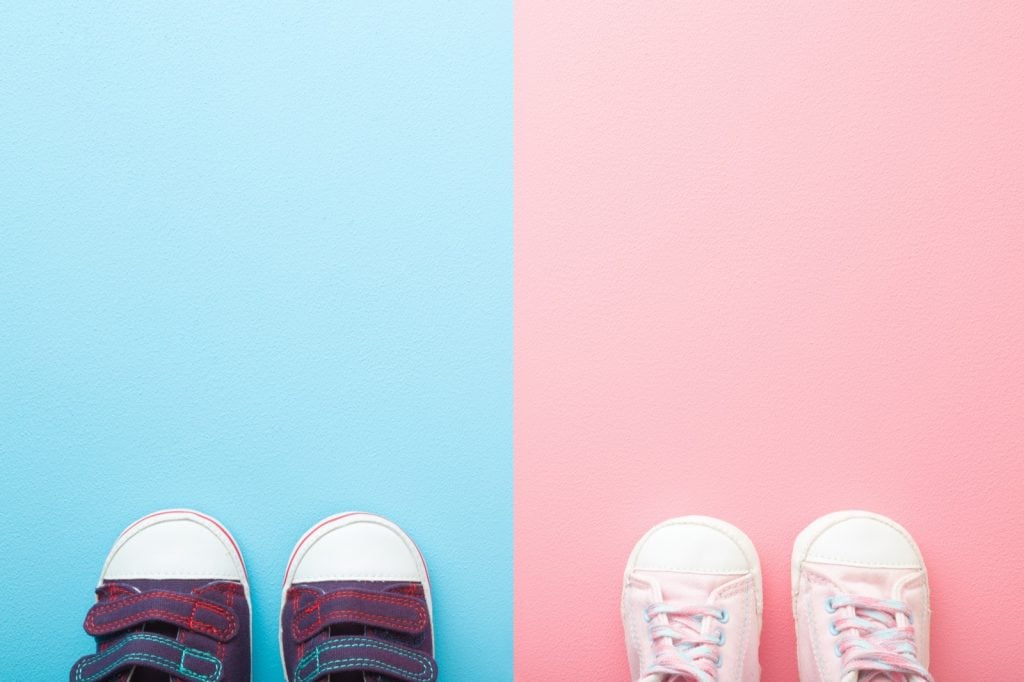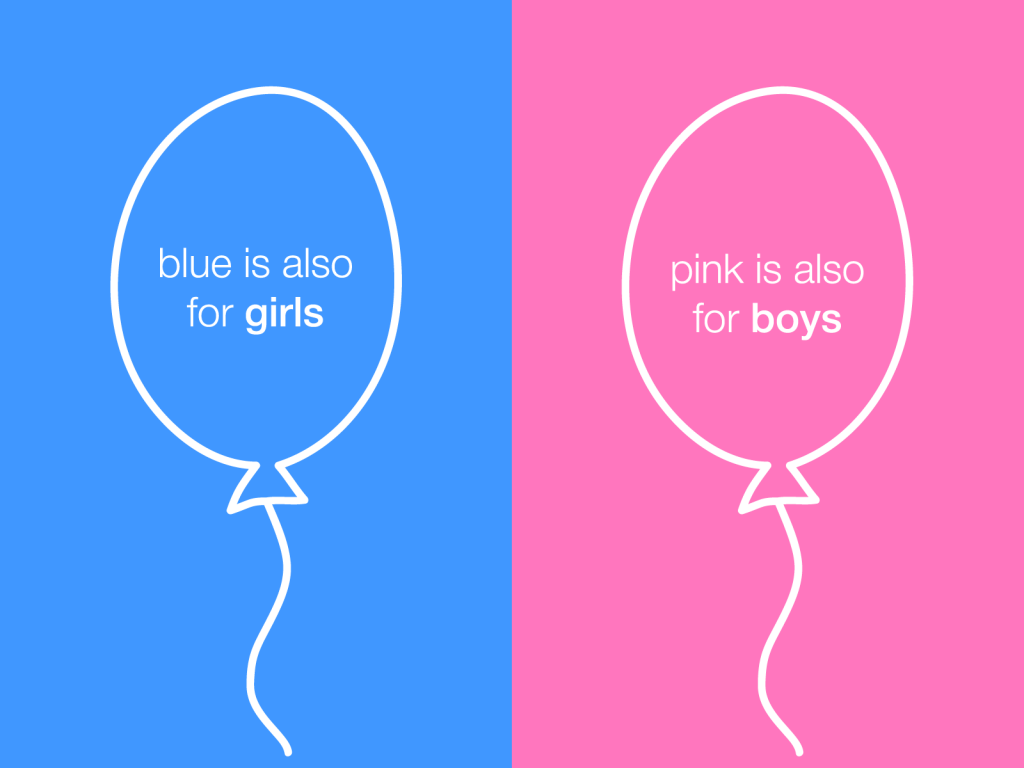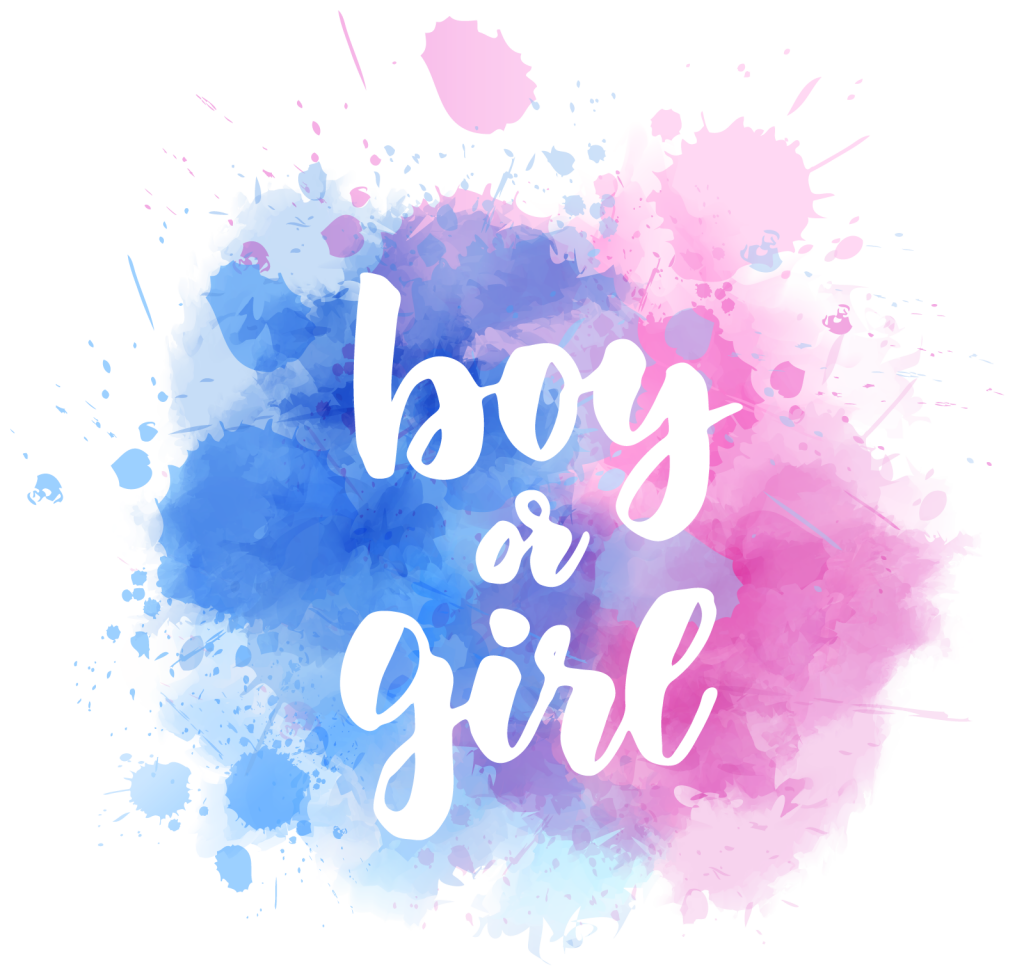Sock Pocket Pink and Blue for a Ipod

While baby clothing and other accoutrements have seen various changes in style in recent years, one tradition persists: pink is for girls and blue is for boys. This trend has become even more pervasive in American culture since the advent of routine ultrasound screening in recent decades. According to a Gallup poll conducted in 2007, two-thirds of Americans between the ages of 18 and 34 reported wanting to know the gender of baby before the child is born, and while updated figures are unavailable, there is no reason to believe that that trend has receded.
Knowing a child's gender before birth has supplanted the traditional unisex baby colors of white, green, and yellow that were popular in decades past when parents, family members and friends were unaware of a child's gender before birth. As more parents know the genders of their children before birth thanks to ultrasound, amniocentesis and genetic screening, shopping for gender-specific clothing has begun earlier, opening a bigger retail window for gendered baby supply purchasing. Retailers, of course, have been glad to embrace the trend in an effort to sell more to consumers.
But where did this cultural trend of "pink is for girls and blue is for boys" originate? It's worth looking at the history of gendered baby colors.
A History of Pink and Blue

The tradition of pink for a girl and blue for a boy seems to have become baked into culture during the latter half of the twentieth century.
Looking further back, in the nineteenth and early twentieth centuries, white was often the color of choice for infants and very young children regardless of gender, largely because it was easier to launder and bleach out stains, and it was historically considered the color of innocence. Both boys and girls were routinely dressed in white dresses for formal occasions and portraiture. A famous photograph of President Franklin Delano Roosevelt as a young child shows the 32nd president dressed in a frilly white dress and patent leather shoes, his long, uncut hair curling on his shoulder. Boys were often dressed as girls until they reached the age of six or seven, at which time they received their first haircut as well as "boy appropriate" clothing.
As children became older, colors were often chosen to complement hair and eye color rather than sex. Pastel colors were considered suitable for infants and young children, but there were no hard rules on which colors were appropriate for which sex – not yet.
While there are historical references to pink for girls and blue for boys going back to the nineteenth century, particularly in Europe, in the early decades of the twentieth century, some retailers reportedly displayed pink clothing for boys and blue clothing for girls.
A June 1918 article published in the trade publicationEarnshaw's Infants' Department noted that, "The generally accepted rule is pink for the boys, and blue for the girls. The reason is that pink, being a more decided and stronger color, is more suitable for the boy, while blue, which is more delicate and dainty, is prettier for the girl." However, at least one researcher has posited that the idea that pink was a male color and blue was a female color a century ago is, in fact, an urban myth.

It wasn't until the 1940s that retailers firmly established the "pink for girls, blue for boys" dynamic, and customer preferences followed suit. With the post-war economic boom, consumers finally had enough cash to purchase new items for their children.
The "pink for girls" trend seems to have accelerated in the years following World War 2, when women left the factories and returned to hearth and home, where they were expected to embrace femininity once again in welcoming their husbands' return to normal family life.
"Rosie the Riveter traded in her factory blues for June Cleaver's pink apron," according to a 2014 NPR report. "Femininity got wrapped in pink, and so did products – from shampoos to fancy fashion."
Essentially, masculinity once expressed in wartime sacrifice, brotherhood and battle increasingly relied on the feminine charms of wives, girlfriends, and sweethearts once the war was over.
Why is Pink "Girly"?

The cultural significance of pink as a feminine color is so established, that it becomes difficult to drop our preconceived notions and wonderwhy pink is feminine.
One theory is that pink is a lighter version of red, and red is the color of romance and emotions, attributes that are more strongly associated with girls and women. And while it's become culturally acceptable for girls to wear blue, many parents would still recoil in horror at the thought of dressing a boy in pink, likely due to traditional notions that boys and men shouldn't "act like girls."
It's worth noting here that while in the twentieth century it became culturally acceptable for girls and women to dress in traditionally male garb such as trousers, shorts, suits and even ties, males dressing in traditionally female garb remains limited to a certain subset of counterculture.
As a color, pink is a relatively recent entrant to textiles. Prior to the eighteenth century, pink was a difficult shade to achieve in cloth. But when it finally became possible, pink was all the rage among fashionable Europeans of both sexes.
The Popularity of Gendered Colors Has Waxed and Waned

Pink for girls and blue for boys has been a trend in the United States since the 1940s, but certain eras saw resistance to the tradition.
In the 1960s and 70s, some corners of feminism rejected overtly frilly and feminine clothing and décor for girls in favor of more tomboyish, unisex clothing. During a two-year period in the 1970s, the trendsetting Sears Roebuck Catalog featured not a single item of pink toddler clothing.
While pink remains popular for girls today, more parents appear to be choosing to dress their children in unisex clothing, swapping traditional colors and even embracing once unheard-of trends in children's clothing: bright, neon colors and even black. Many parents today view the embrace of traditional pink-for-girls and blue-for-boys norms in clothing, toys and décor as limiting to their children's personal development.
Are Gendered Colors Hardwired into our Biology?

The idea that there's something innately biological about female preferences for pink and male preferences for blue has been studied by a variety of researchers. A study conducted in the mid-2000s by researchers at the University of Newcastle upon Tyne, England tested the color preferences of 171 British adults and 37 recent immigrants to the UK from mainland China. The study, which tested an equal number of men and women, found that both sexes rated blues as best. This result has also been found in other studies on the subject. The researchers did find, however, that women showed a significantly higher preference for blues that contain "pinkish" undertones (think lilac or lavender), whereas the male subjects tended to prefer purer blue shades.
Inclusion of Chinese participants was important. Whereas girls and women in Western nations have likely been nurtured into preferring pink thanks to marketing, women who grew up in China were less likely to have learned "pink is for girls" in the absence of Western toys and apparel. Lead researcher Anya Hurlbert said she believes the research concludes that a preference for pink among females is innate, and that it could be linked to women's primary function as gatherers in the hunter-gatherer period of human development. Successful gatherers would have benefited from an ability to recognize ripeness in fruits, which is often signified by the color pink. In turn, they may have passed this ability on to their daughters.
"Evolution may have driven females to prefer reddish colors – reddish fruits, healthy, reddish faces," Hurlbert said. "Culture may exploit and compound this natural female preference."

Since the publication of the University of Newcastle study, other research has come up short on a biological link between females and an inborn preference for the color pink. A study conducted by Vanessa LoBue of Rutgers, The State University of New Jersey, and Judy DeLoache of the University of Virginia examined color preferences in a sectional sample of children aged seven months to five years. The resulting data showed no evidence of any preference for pink in early infancy.
"However, beginning around the age of two, boys and girls diverged in their responses to this particular color," according to the study's authors. "Girls' liking for pink increased between two and three years of age and remained high through four years. In contrast, boys' response to pink showed a dramatic decline between three and four years of age. There was no significant gender difference in the frequency of choosing pink in the youngest two age groups (infants under the age of two). However, in the two-, three-, four- and five-year-old age groups, the girls chose pink significantly more often than the boys did."
This suggests that a preference for pink is the result of culture and socialization rather than an inborn trait. In fact, many studies have found that babies of both sexes show a marked preference for bright colors rather than pastel shades.
"Children take in the world around them through their eyes, and bright colors are one of the first aspects of sight that help them distinguish form and categorize objects," wrote Rachel Pancare for Sciencing. "These colors appeal to young children, as they are easier for them to see. At about five months old, children can see colors with their still-developing vision, though distinguishing bright colors comes easier to them. As children age, they continue to be drawn to brighter colors."
Pink and Blue Aren't Only About Clothing

With the new (and some might say, "over the top") trend in gender reveal parties, or celebrations focused on family and friends learning the sex of an expected child, pink and blue have reemerged as the symbols of girlhood and boyhood. In a shower of pink or blue confetti, glitter, cupcakes, streamers, party favors, and even in some cases fireworks and explosives, Americans have found a new use for gendered colors.
"There's this huge pressure to publicize these once-private moments," Carly Gieseler, an associate professor at the City University of New York's York College, told the Associated Press. "You get that outside validation that what you did was unique, that it was extra special. It drives celebrations to the extreme because you're trying to do the thing that no one's done before."
The use of pink and blue in gender-reveal parties is probably driven by a desire for page views, clicks, followers, likes and advertising revenue. For this reason, gender reveals are reaching new levels of outlandish, aggrandized attention-seeking. In two separate incidents, American couples revealed their child's gender by putting items containing red or blue substancesinto the mouths of their pet alligators, and the children's genders were revealed when the alligator chomped the balloon or the watermelon. Yes, you read that right.
Pink is for Whomever, and Blue is for Whomever

The United States is a nation of contrasts, and while the use of pink and blue in gender reveal parties is on the rise, at the same time, younger Americans are increasingly rejecting the gender binary. The New York Times has reported that during the last few years, nonbinary identity has been slowly seeping into societal consciousness.
"A nonbinary actor, Asia Kate Dillon, has starred since 2017 as a nonbinary character on the Showtime series 'Billions,'" according to theNY Times' Daniel Bergner. "A raft of new nonbinary models are featured in fashion spreads, and a Coke ad, aired during the 2018 Super Bowl, paired an androgynous face with a pointed gender-neutral pronoun. 'There's a Coke,' the voice-over said, 'for he and she and her and me and them.'"
As the country experiences a bifurcation of culture – in politics, social sciences, and governance – the poles may also be aligning between those who value traditional gendered colors and those who reject them. Not to mention a gap between people who believe that alligators should be involved in gender reveals and those that prefer a ceremony without dangerous, predatory reptiles.
One way or another, it appears clear that the pink-and-blue symbolism is unlikely to disappear from American culture anytime soon.

Sock Pocket Pink and Blue for a Ipod
Source: https://www.color-meanings.com/genders-and-colors-why-is-pink-for-girls-and-blue-for-boys/
0 Response to "Sock Pocket Pink and Blue for a Ipod"
Post a Comment